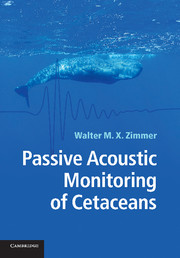Part III - Passive acoustic monitoring (putting it all together)
Published online by Cambridge University Press: 26 April 2011
Summary
After presenting the tools required to carry out PAM, the third part of this book discusses the operational aspect of how PAM may be used. PAM is a rather new direction in cetacean research, which so far has mostly been visually oriented. However, with the availability of affordable instrumentation and the increasing cost of human-operated ship-based surveys, PAM is becoming increasingly interesting for both cetacean stock management and risk mitigation, especially when carried out with small autonomous platforms.
The implementation of PAM systems depends very much on the application and operational circumstances. Chapter 7 addresses some PAM applications and indicates a few difficulties one may encounter during the analysis of acoustic data, at least when applying classical techniques known from visually oriented applications. Chapter 8 addresses the detection function, which plays an important role in assessing the population density using survey methods. Chapter 9 introduces computer simulation as a technique to emulate real-world PAM with the intention of demonstrating, not only the usefulness of simulations to generate data, but also how to analyse PAM system performance. The last chapter of this book addresses some systems issues that are fundamental in any PAM implementation, and discusses relevant aspects of PAM hardware and software.
- Type
- Chapter
- Information
- Passive Acoustic Monitoring of Cetaceans , pp. 237 - 238Publisher: Cambridge University PressPrint publication year: 2011



